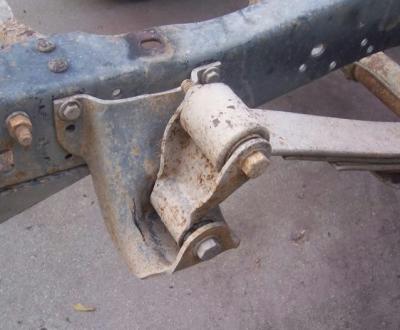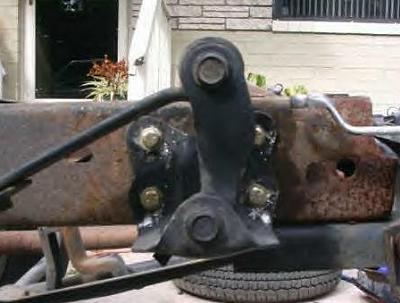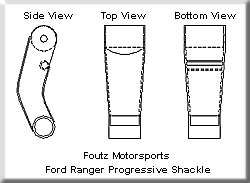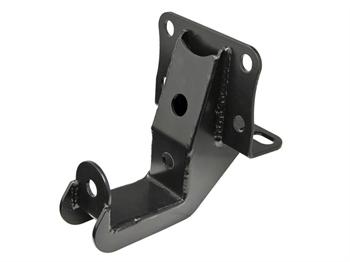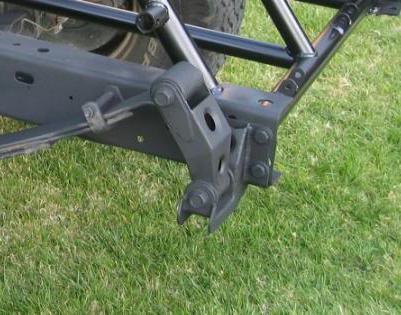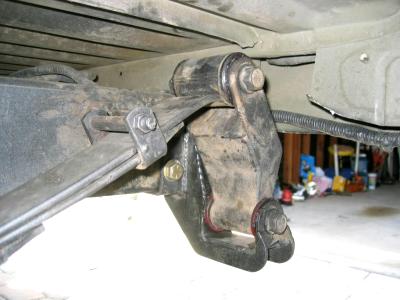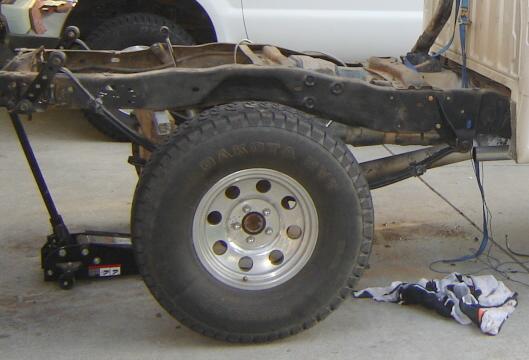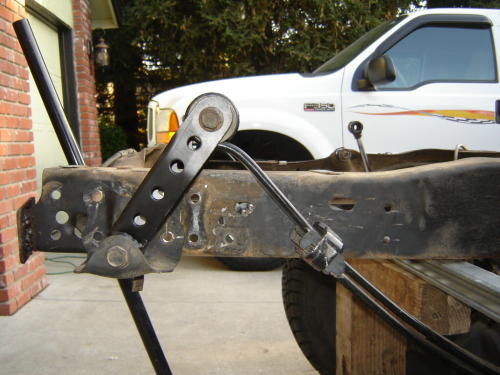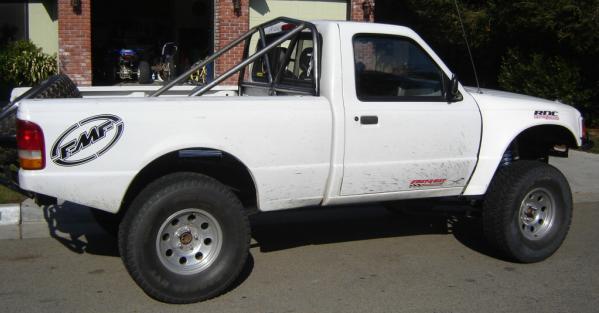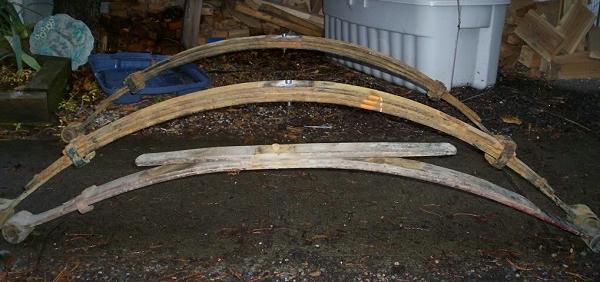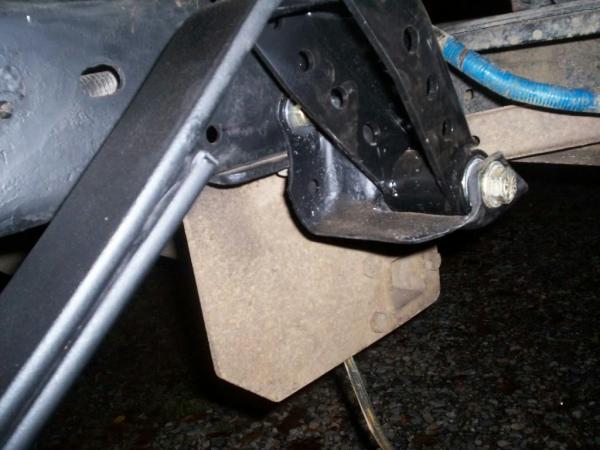
Chevy Leaf Springs – 63-Inch Or 64-Inch:
Lets first clarify that there isn’t a 63-inch Chevy leaf spring. The fullsize Chevy truck (from 1973-1999) came with either 54-Inch, 56-inch or 64-Inch leaf springs.

Those that are measuring their springs at 63-Inches aren’t measuring correctly. You have to follow along the springs when you measure.
Spring manufacturers measure their springs like shown in the diagram above.
Note the longer Chevy 64-Inch leaf spring versus the Ford Ranger 57-Inch (56-5/8″) leaf spring
64-Inch Spring Swap and Shackle Flip:
Some people have done a 64-inch spring swap with a longer shackle to gain lift, but did not do a shackle flip. This IS NOT that type of setup. This setup is designed to greatly increase wheel travel.
The stock Chevy leaf configuration uses a rear shackle that rides above the hanger:
Whereas the Ford Ranger uses a rear shackle that rides below the hanger:
To gain a lot of wheel travel in the rear suspension, you can flip the hanger over for the rear shackle mount and run it upside down. In addition you can lengthen the shackle, and it improves the handling considerably. By flipping it over, it will lower the ride height, center of gravity, and make the truck easier to drive. A longer shackle will give you more travel.
This isn’t a new concept, and anyone you’ve seen post about it likely wasn’t the originator. This idea was first published on the internet back in 1998 by desert truck racer Greg Foutz. This is what Greg had to say about it then:
| “By removing the shackle hanger from the frame and turning it over so the shackle stands above it rather than hanging down from it you get several advantages. Here they are:It lowers the center of gravity of the vehicle by lowering the functional pivot point of the shackle and sprint
It allows you to enhance the wheel travel by using a longer shackle without raising the height of the truck. It also gives you a better ride in the small bumps ( less than 8-10″) It will allow you to let the bump stop be higher in the wheel travel due to the fact that when the spring is fully compressed in the rear end, the mounting point where the shackle pivots is higher in the relationship to the frame. The spring is less likely to break due to not forcing it past is Zero point. This is when the spring is lost all arch in the normal direction to hold the truck up and starts in the negative arch. This is the major factor in spring breakage. By changing the perch and building the longer shackle you can get about 18″ of rear wheel travel with the proper shock. Sway-Away has just lowered their prices on the 3″ body shocks they sell. This is the best deal on the planet. I am a believer in their product and they will sell you a shock that is longer than the normal 14″ travel. They sell shocks all the way up to 20″ of travel. When considering this shackle flip you will need to think about it a lot. The stock perches that are used on the Ranger are symmetrical. That means that you can take the stock bracket and flip it over without drilling any holes or anything special. The perches are riveted on the frame and this proves to be the trickiest part of the job.” |
So the goal is to go from this:
Above is the rear shackle in the stock location.
To this:
Above is what it looks like when it is flipped.
You can get an idea from the picture below how the shackle will rotate forward and drop to allow more downward wheel travel in the suspension
The Shackle:
Greg Foutz spoke about the shackle design back in the article he wrote in 1998:
| “I have enclosed a picture of a shackle design that I did a few years ago. You will see them on a lot of the 7 and 7s trucks now. It is a progressive design that allows for nice light resistance toward the first 4 inches of the travel and then stiffer after that. This design proves to give you a better more comfortable ride. Combine this will a good spring and shock and you will be blown away.”
|
Camburg offers a similar shackle today:
Camburg Shackles
Belltech offers P/N 6400 as a drop shackle for lowering Chevy trucks. Some guys have used them to replace the Ford Ranger shackle for lift when mounted in the stock configuration. In a shackle flip setup, they would actually make the spring sit higher and reduce ride height, which is what they were designed to do on the Chevy’s.
Shackle Mounts:
Kartek offers a replacement Shackle Mount for the Ranger. These Ranger Shackle Mounts offer stronger leaf spring mounts than stock. The drop mounts are available with either stock height or with a 1-1/2″ drop for extra ride height and clearance.
Kartek Drop Shackle Mount
Camburg shackle in Kartek stock height mount
Lowered shackle mount
Front Spring Hanger:
To compensate for the longer leafs, the front mount (spring hanger) is moved forward so the bottom left hole of the bracket is relocated into the bottom right hole in the frame.
How Much Lift Will You Get:
None. Sorry to crush your hopes and dreams. When using the Chevy springs, 6400 shackles, and inverting your rear hangers, you do not gain any height, but you gain articulation. Some people have had their springs re-arched, but it’s questionable how well the old fatigued metal in the springs will hold the new arch and keep the lift.
Logic tells us that a Chevy lift spring would provide lift in this setup, but we haven’t found any information as to how much lift a 4″, 6″, 8″ or more lift spring would add to the Ranger.
Custom Packs For Lift:
People who build long travel rear suspensions with the Chevy Leafs and shackle flips on the Ranger do so by building custom spring packs. They start with the Chevy 64-Inch leaf’s and add other leaf’s for more lift. It’s a trial-and-error process, and it seems everyone has their own formula. The leaf’s aren’t even all Chevy. They have used Ford and other manufacturers leaf’s in their packs.
RaceRanger97’s conversion:
Here’s some photos of the 64-inch leaf swap and shackle flip conversion done by RaceRanger97 (TRS forum member) to gain a lot of rear wheel travel.
In the photo above, the owner used a 64-inch leaf spring from a 1/2-ton Chevy/GMC pickup that he had re-arched 12-inches at a local spring shop.
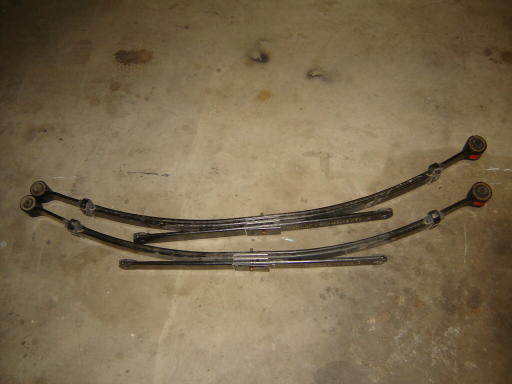
Stock GM 64-inch leafs above.

Above are the leafs after being re-arched.
The rear hanger was flipped and a 7-inch shackle was used.
As the rear suspension droops, the shackle droops as well to provide more travel.
To compensate for the longer leafs, the front mount (spring hanger) is move forward so the bottom left hole of the bracket is relocated into the bottom right hole in the frame.
Here you can see it all together. The owner ran out of jack trying the lift the rear of the truck up to check wheel travel.
Here’s the truck sitting normal.
Andres629’s Conversion:
Forum member Andres629 did a 64-Inch Chevy leaf swap with the Belltech 6400 shackle flip. His Ranger had a 4-Inch suspension lift, but he broke a rear spring. He had the 64-Inch leafs re-arch 13-Inches in installed them with a shackle flip, Belltech 6400 shackles and eliminated the lift block.
Chevy 64-Inch leafs with the 13-inch arch next to a stock Ranger leaf
Shackle flip with Belltech 6400 shackle
After installation
Andres629 ended up adding a 3-inch lift block in the rear to level the truck. If he had kept the stock shackle (but flipped) instead of the longer (lowering) Belltech shackle, and the factory lift block, he probably would have had enough lift with the 13-inches or arch to be level.
Resources:
Jim Oaks is the founder of TheRangerStation.com, the longest-running Ford Ranger resource online since 1999. With over 25 years of hands-on experience building and modifying Ford Rangers — including magazine-featured builds like Project Transformer — Jim has become one of the most trusted authorities in the Ford Ranger off-road and enthusiast space. In 2019, he was loaned a Ranger FX4 by Ford Motor Company to test and document across the TransAmerica Trail. Jim continues to inspire and guide Ranger owners around the world.


